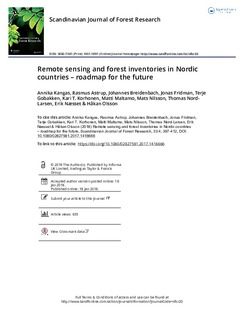| dc.contributor.author | Kangas, Annika | |
| dc.contributor.author | Astrup, Rasmus Andreas | |
| dc.contributor.author | Breidenbach, Johannes | |
| dc.contributor.author | Fridman, Jonas | |
| dc.contributor.author | Gobakken, Terje | |
| dc.contributor.author | Korhonen, Kari T. | |
| dc.contributor.author | Maltamo, Matti | |
| dc.contributor.author | Nilsson, Mats | |
| dc.contributor.author | Nord-Larsen, Thomas | |
| dc.contributor.author | Næsset, Erik | |
| dc.contributor.author | Olsson, Håkan | |
| dc.date.accessioned | 2018-10-10T08:44:51Z | |
| dc.date.available | 2018-10-10T08:44:51Z | |
| dc.date.created | 2018-05-22T10:42:30Z | |
| dc.date.issued | 2018 | |
| dc.identifier.citation | Scandinavian Journal of Forest Research. 2018, 33 (4), 397-412. | nb_NO |
| dc.identifier.issn | 0282-7581 | |
| dc.identifier.uri | http://hdl.handle.net/11250/2567314 | |
| dc.description.abstract | The Nordic countries have long traditions in forest inventory and remote sensing (RS). In sample-based national forest inventories (NFIs), utilization of aerial photographs started during the 1960s, satellite images during the 1980s, laser scanning during the 2000s, and photogrammetric point clouds during the 2010s. In forest management inventories (FMI), utilization of aerial photos started during the 1940s and laser scanning during the 2000s. However, so far, RS has mostly been used for map production and research rather than for estimation of regional parameters or inference on their accuracy. In recent years, the RS technology has been developing very fast. At the same time, the needs for information are constantly increasing. New technologies have created possibilities for cost-efficient production of accurate, large area forest data sets, which also will change the way forest inventories are done in the future. In this study, we analyse the state-of-the-art both in the NFIs and FMIs in the Nordic countries. We identify the benefits and drawbacks of different RS materials and data acquisition approaches with different user perspectives. Based on the analysis, we identify the needs for further development and emerging research questions. We also discuss alternatives for ownership of the data and cost-sharing between different actors in the field. | |
| dc.language.iso | eng | nb_NO |
| dc.rights | Attribution-NonCommercial-NoDerivatives 4.0 Internasjonal | * |
| dc.rights.uri | http://creativecommons.org/licenses/by-nc-nd/4.0/deed.no | * |
| dc.title | Remote sensing and forest inventories in Nordic countries - roadmap for the future | nb_NO |
| dc.type | Journal article | nb_NO |
| dc.type | Peer reviewed | nb_NO |
| dc.description.version | publishedVersion | |
| dc.source.pagenumber | 397-412 | nb_NO |
| dc.source.volume | 33 | nb_NO |
| dc.source.journal | Scandinavian Journal of Forest Research | nb_NO |
| dc.source.issue | 4 | nb_NO |
| dc.identifier.doi | 10.1080/02827581.2017.1416666 | |
| dc.identifier.cristin | 1585856 | |
| cristin.unitcode | 192,14,0,0 | |
| cristin.unitname | Miljøvitenskap og naturforvaltning | |
| cristin.ispublished | true | |
| cristin.fulltext | original | |
| cristin.qualitycode | 1 | |

